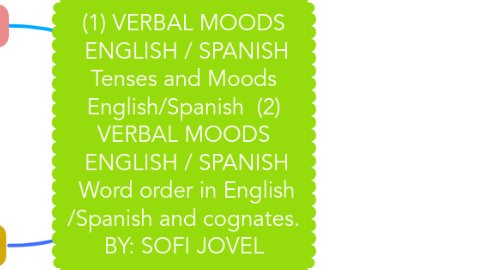
1. Cognates
1.1. Cognates are words in two languages that share a similar meaning, spelling, and pronunciation
1.1.1. ENGLISH – SPANISH COGNATES
1.1.1.1. Actor Actor
1.1.1.2. Admirable Admirable
1.1.1.3. Agenda Agenda
1.1.1.4. Alcohol Alcohol
2. False Cognates.
2.1. False cognates or false friends, they are words that are spelt the same or similar but mean completely different things.
2.1.1. ENGLISH – SPANISH FALSE COGNATES
2.1.1.1. Advertisement advertencia
2.1.1.2. Assist asistir
2.1.1.3. Carpet carpeta
2.1.1.4. College colegio
3. Tenses in English.
3.1. Tense (noun): a verb-based method used to indicate the time, and sometimes the continuation or completeness, of an action or state in relation to the time of speaking
3.1.1. English tenses: time and aspect.
3.1.1.1. Time is a concept which is related to our perception of reality. There are three times: past, present and future.
3.1.1.2. Aspect is a grammatical category that expresses how an action, event, or state, denoted by a verb, extends over time.
3.1.1.2.1. Importance of Tense
4. Moods in English.
4.1. Mood, also called mode, in grammar, a category that reflects the speaker’s view of the ontological character of an event. This character may be, for example, real or unreal, certain or possible, wished or demanded.
4.1.1. Most common moods in English
4.1.1.1. The indicative (indicating a state of factuality and reality)
4.1.1.2. Subjunctive mood (indicating a hypothetical state, a state contrary to reality, such as a wish, a desire, or an imaginary situation
4.1.1.3. The imperative (indicating a state of command)
4.1.1.4. The interrogative (indicating a state of questioning)
5. Moods in Spanish.
5.1. Llamamos tiempos al conjunto de formas verbales que presentan la acción de la misma manera y corresponden a un mismo tiempo (pasado, presente o futuro)
5.1.1. CUÁNDO se realizó la acción del verbo:
5.1.1.1. PRESENTE. El verbo expresa acciones que se están realizando ahora mismo según la expresión del hablante
5.1.1.2. PASADO. El verbo expresa acciones que ya han pasado. Hay distintos grados del pasado.
5.1.1.3. FUTURO. El verbo expresa acciones que aún no han pasado. Hay distintos grados del futuro
6. Word order in English.
6.1. Word order in English is important, because it can change the spirit, meaning or fluency of a sentence.
6.1.1. Word Order in English
6.1.1.1. Standard word order is the most common sentence pattern in English. The SUBJECT comes before the VERB.
7. Word order in Spanish.
7.1. Por lo general, el español presenta la información discursiva con el siguiente orden de palabras: sujeto (S), verbo (V) y objeto (o). Esta combinación se acompaña de frases adverbiales en la posición final, es decir, se presentan después del objeto.
7.1.1. 2 Tipos principales de orden
7.1.1.1. Orden natural Sujeto-Verbo-Objeto-Complementos adverbiales
7.1.1.2. Orden invertido Complementos adverbiales-Sujeto-Verbo-Objeto
